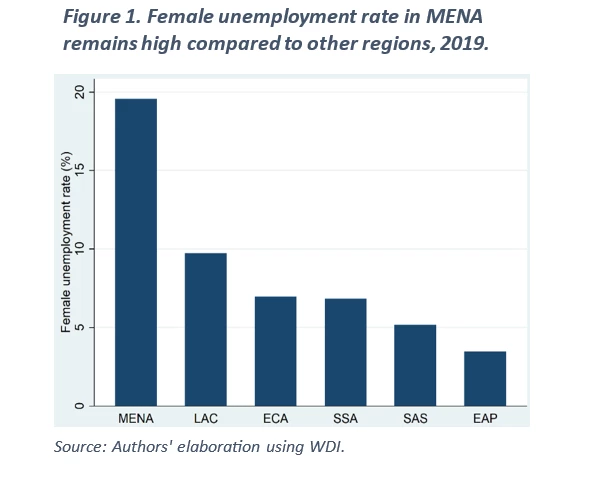 Two inspectors at a glass factory. (Shutterstock.com/Chachamp)
Two inspectors at a glass factory. (Shutterstock.com/Chachamp)
Following trade liberalization in the Middle East and North Africa (MENA) during the early 2000s, the region experienced an economic boom. Total trade in the region (excluding high-income countries) rose sharply from 61% of gross domestic product (GDP) to 73% in 2000-2008. Yet, during these years of sustained economic growth in the region, poverty, inequality, low wages, informality, and low female labor force participation (FLFP) persisted. Improving labor-market outcomes is key for governments striving to promote stability through inclusive and sustainable economic growth.
Trade liberalization (such as signing and implementing trade agreements) has a strong record of promoting economic growth around the world. Our new World Bank report, Exports to Improve Labor Markets in the Middle East and North Africa, sheds light on why rising trade in MENA failed to improve labor-market outcomes. The report analyzes changes in trade flows, the relationship between trade shocks and job creation, and firm behavior in the face of trade liberalization. To illustrate the differences within MENA, we focused on three diverse countries: Egypt, Morocco, and Tunisia. Our results can be summarized with these two points:
- MENA’S trade agreements effectively increase trade. Between 1990 and 2019, the three countries signed numerous regional trade agreements and reduced tariffs, leading to increased trade flows. Between 1998 and 2022, for example, Egypt and Morocco implemented seven regional trade agreements (RTAs) each, and Tunisia four. Economic growth followed the increase in trade flows, as expected.
- But trade did not necessarily translate into improved labor market outcomes. Despite the benefits of the many RTAs on economic growth, labor market outcomes did not improve in Egypt, Morocco, and Tunisia as expected. As trade flows shift and new agreements are signed, winners and losers emerge.
Unemployment remains high, especially for women and youth. Our findings suggest that foreign demand shocks that were concentrated in male-intensive industries limited employment opportunities for women. In Morocco and Tunisia, trade policies lowered informality, but deterred women from participating in the labor force. While rising exports increased employment in Egypt, real wages decreased and no meaningful improvements in informality or female labor force participation occurred. And our estimates for Tunisia reveal that a US$1 billion increase in export exposure leads to an average decrease of 6.8 percentage points in the female-to-male employment ratio.
Our findings are consistent with aggregate indicators revealing that women in MENA face greater challenges in accessing job opportunities compared to women in other developing regions (see Figure 1). There are two key explanations:
- Exports favored male-intensive industries.
- Gender segmentation for both occupation and industry creates barriers for women that limit their ability to move into expanding industries and take advantage of expanding exports.
Countries, however, can create more inclusive and sustainable labor markets by following these targeted policies from our report that can address the challenges of unemployment, gender biases, and unequal distribution of trade benefits:
- Continuing trade expansion: Since trade agreements seem to be working, expanding the portfolio of agreements for MENA partners should be encouraged. Regional trade integration is key because as distance increases, trade agreement effectiveness decreases.
- Reduce gender-biased industry and occupation segmentation: Reforms should aim to create an enabling environment that allows women to access a wider range of sectors and job opportunities. Reducing gender segmentation in labor markets can decrease the effects of foreign demand shocks on gender inequality. If sectors had no gender segmentation, any foreign shocks would be distributionally neutral across genders. For instance, the industries that expanded during trade liberalization were more technological and capital intensive, which often required more STEM training. Subsidizing STEM education and training for women in high-demand areas within exporting industries can help break down barriers and spread the benefits of trade agreements more widely.
- Targeting labor-market adjustment costs for existing workers, especially women: Women faced a relative decline in demand when female-intensive industries experienced rising import competition and falling export demand. Many of these women found it preferable to simply drop out of the labor force rather than to move into other sectors. This finding suggests that the costs for existing female workers to move between industries or occupations are quite high. Reducing these costs would help existing workers take advantage of shifts in export demand and help spread the benefits of trade agreements more widely. These policies include supported job search (information), training, and other active labor market policies.
- Deepening reforms to maximize trade benefits: To fully seize the benefits of trade, countries need to undertake deeper reforms. This includes improving the business environment, reducing investment barriers (especially for foreign direct investment), lowering costs for firms to formalize, and making the private sector more attractive than the public sector in terms of wages and job security. These reforms will help countries integrate into global value chains and promote labor-intensive industries.






Join the Conversation